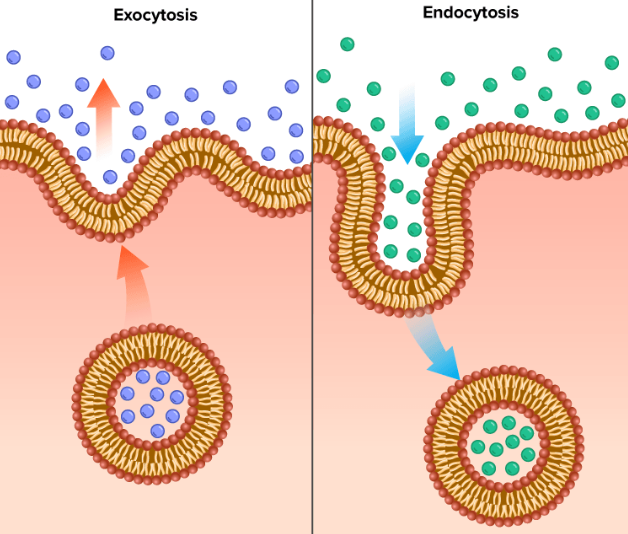Ch. 5: ATP & Cellular Work
1/44
Earn XP
Description and Tags
Exam 2 Study Guide
Name | Mastery | Learn | Test | Matching | Spaced |
|---|
No study sessions yet.
45 Terms
What are the reactants for cellular respiration? What are the products? What is a by product?
Reactants: Organic molecule (like sugar) + oxygen
Products: carbon dioxide and water
By-product: heat
What is a calorie?
It is the amount of energy that can raise the temp of 1 gram of water by 1 degree Celsius
What is ATP stand for? What is it made out of? What is it used for?
- Adenosine triphosphate.
- Made out of adenosine and three negatively charged phosphate group tails
- Like a compressed spring, it’s crowding contributes to the potential energy of the molecule.
- It is used to provide energy tor cellular work
How does ATP provide energy for cellular work?
Since it’s like a compressed spring, the release of the outermost phosphate tail is what provides power and the molecule becomes adenosine diphosphate (ADP)
How does ATP energize other molecules?
- They break off the tip phosphate tail and attaches it to the target molecule. By accepting the third phosphate group, it becomes energized
Name three ways ATP powers cellular work:
- Used to power motor proteins for mechanical work (muscle movement)
- Used to transport proteins (importing solutes)
- Used to promote a chemical reaction
Can ADP be reused? If so, how?
- By adding a phosphate group back to ADP
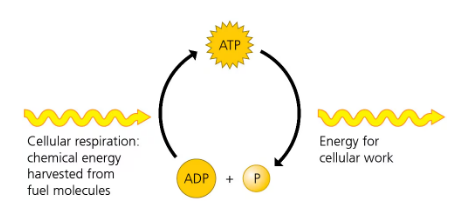
Define metabolism.
- Metabolism is the total of all the chemical reactions in an organism
What is an enzyme?
- Enzymes are biological catalysts that speed up chemical reaction by lowering the activation energy that’s needed for the reaction to occur.
What is an activation energy?
- It is the energy that’s needed to break the bonds in the reactants first. Like the energy/effort you need to clean your room.

Do enzymes get consumed by the reaction?
- No. They are recycled and reused.
What type of molecules can enzymes act on?
- Substrates.
Can enzymes react on any substrate?
- No. They are highly specific.
Lactose – broken down by lactase
Where do substrates attach to on an enzyme?
- They attach to the active site. Usually a pocket or groove on the enzymes surface.
What do you call when an enzyme “hugs” the substrate?
Induced fit
Describe how enzymes work.
- The empty active site on enzyme (lactase) accepts the substrate (lactose)
- The enzyme catalyses the reaction (hydrolysis reaction) and converts substrate to products (glucose & galactose)
- The products are released and lactase can accept another molecule of substrate
What are enzyme inhibitors?
- They are molecules that can stop a metabolic reaction by affecting the enzymes function
What are the two types of inhibitors? Describe their function.
- Substrate imposters: these are the inhibitors that look similar to to the enzyme’s normal substrate. Their binding blocks the actual substrates from binding.
- Allosteric inhibitors: these are molecules that bind to a different part of the enzyme and changes the shape and ultimately changes the function of the enzyme or make it no longer work.
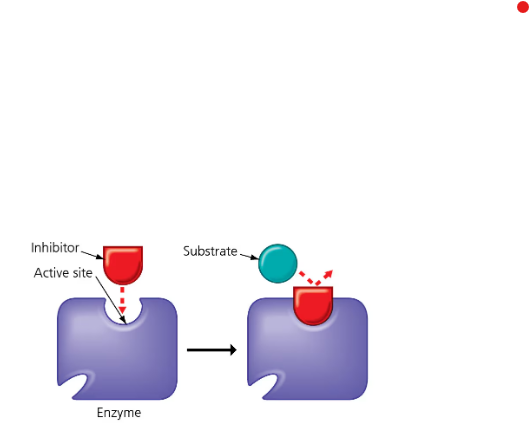
What type of enzyme inhibitor does this image illustrate?
Substrate imposter. The inhibitor looks similar to the substrate.

What type of enzyme inhibitor does this image illustrate?
Allosteric inhibition. The inhibitor binds to a remote part of the enzyme.
What is reversible inhibition?
- Some inhibitors can be removed
- Like when a product of a reaction blocks an enzyme temporarily which stops the cell from making too much of the product
Give examples of drug inhibitors and what they do:
- Penicillin: blocks an enzyme bacteria needed to make their cell walls
- Ibuprofen: blocks an enzyme involved in pain signals
- Cancer drugs: stop enzymes that promote cell division
Give examples of toxins and poisons that work as inhibitors:
- Nerve gases: irreversibly blocks an enzyme important for nerve signals -> causing paralysis
- Pesticides: kill insects by inhibiting the same enzyme needed for nerve signals
What is the function of a plasma membrane?
- It’s semi permeability only allows certain molecules to pass which regulate the flow of materials to and from the environment
Give 5 functions of embedded proteins within the cell membrane:
- Cell signaling: it’s when a binding site fits the shape of a chemical messenger which causes a change in the protein that relays the message to the inside of the cell
- Enzymatic activity: enzymes have an active site that fit a substrate and form an assembly line that carries out steps of a pathway (electron transport chain?)
- Cell-cell recognition: some proteins with chains of sugars serve as identification
- Intercellular joining: proteins may link adjacent cells
- Transport: some proteins provide a channel that a chemical substance can pass through
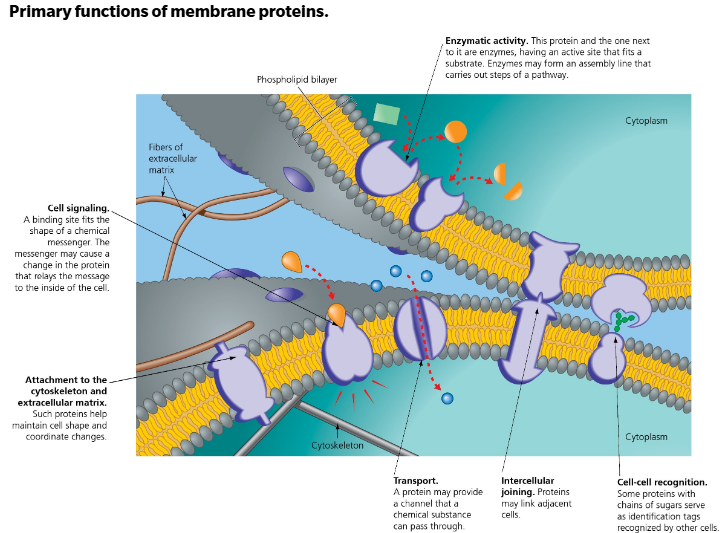
What is diffusion?
- Diffusion is the process where molecules spread out evenly into available space
- It usually is the movement of molecules from regions of higher molecule concentration to lower concentration
What is diffusion equilibrium?
- It is when molecules continue to move but at equal rates
- Both sides of a membrane have equal concentration of molecules
What is passive transport?
- Diffusion across membrane where no energy required from the cell
How does size and polarity affect the membranes permeability to solutes?
- Allows smaller molecules like oxygen to pass through easier than larger molecules like amino acids
- Some Ions are blocked due to the membranes hydrophobic nature
Can molecules that have high lipid solubility pass through the membrane easily?
- Yes. The higher the lipid solubility the faster the diffusion of the molecules
How do molecules like glucose cross the membrane?
- Through protein channels and carriers (facilitated)
What is facilitated diffusion?
- Glucose and water (polar molecules) cannot pass through easily or at all so they use transport proteins to help them move across
- Still passive. No energy required from cell
Can be saturated
What do you call the proteins that transport water?
- Aquaporins
What is osmosis?
- It is the diffusion of water across a semi-permeable membrane
Describe what a solute, solvent and solution is. Give an example.
- A solute is a substance that’s dissolved in the solvent which creates a solution.
- Salt (solute) is dissolved in water (solvent) which creates saltwater (solution)
What is a hypotonic solution?
- A solution that has a lower concentration of solutes compared to another one
What is a hypertonic solution?
- A solution that has a higher concentration of solutes compared to another one
What is an isotonic solution?
- It is a solution that has an equal amount of solutes compared to another one
Describe how animal cells react in those three different solutions.
- In a hypotonic solution, where there’s more solutes inside of the animal cell, water moves towards the cell and results in a lysed cell (bursting)
- In a hypertonic solution, where there’s more solutes outside of the animal cell, water moves outward, shrinking the cell
- In an isotonic solution, the animal cell thrives. There’s en equal amount of solutes inside and outside of the cell which allows the water to diffuse at an equal rate
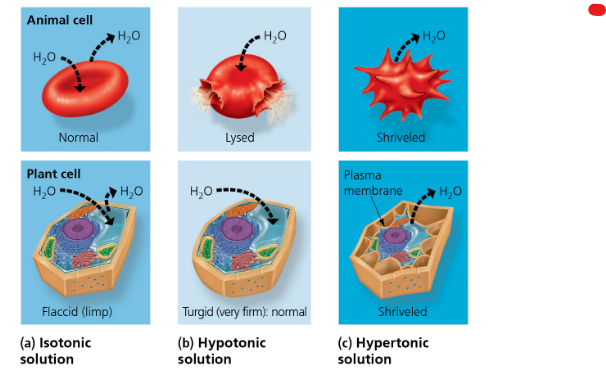
What is the process called where animals balance the uptake and loss of water for hypotonic and hypertonic environments?
- Osmoregulation
What is dehydration? What is hypoatremia?
- Dehydrated is when cells have too little water.
- Hypoatremia is when cells have too much water and overdilutes necessary ions – drinking too much water can be bad for you and your kidneys! Has even caused death.
How do different solutions affect plant cells?
- In hypotonic solutions, plant cells thrive and are turgid. Water moved into the plant cells and the elastic wall expands a bit but the back pressure it exerts prevents the cell from taking in too much water and bursting
- In a hypertonic solution, the plant cell shrivels because water moves out of the plant cells just like in animal cells
- In an isotonic solution, the plant is flaccid and wilts
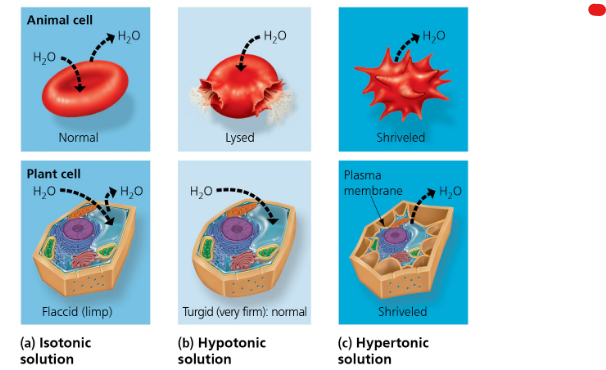
What is active transport?
- Active transport requires that a cell use energy to move molecules across a membrane
- Usually needed to move solutes against its concentration gradient (low to high)
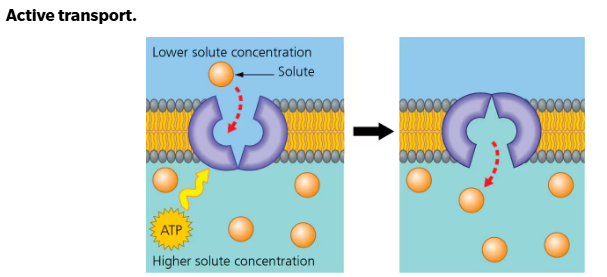
What is NA/K pump?
- It is a carrier protein that transport sodium and potassium (polar molecules) through the membrane
- 321 NoKIA (3 Na out, 2 K in, 1 ATP used)
How do large molecules get transported across a membrane?
- They are either secreted through a vesicle that fuses with the membrane (exocytosis) or
- They are engulfed by the cell membrane (endocytosis) and buds inward to form a vesicle like phagocytosis
